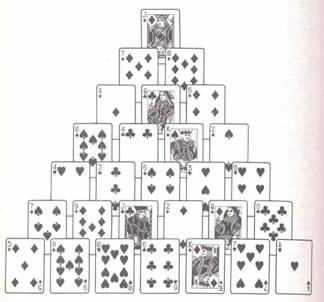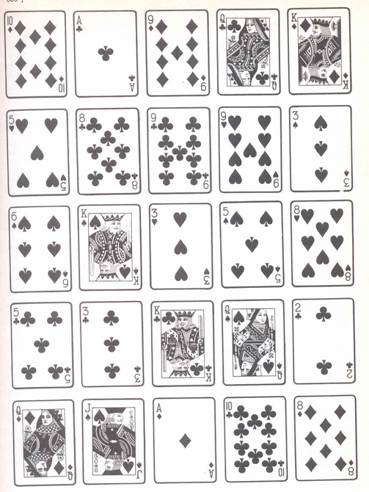SINGLE – DECK SOLITAIRE
Simple Addition
Grouped under this name are several solitaire of elementary character, alike in object and procedure.
Play. Deal a tableau as directed below. Remove cards from the tableau in groups and discard. The groups must be specified face cards, or cards that make a specified total. Aces count 1 and, where they have any numerical value, the jacks count 11, queens 12, and kings 13. Fill spaces in the tableau by cards from the hand. The game is won if entire pack is discarded or dealt into the tableau.
Elevens. The tableau is nine cards in three rows of three. Discard jacks, queens, kings in trios of one each rank, regardless of suits. Discard all other cards in pairs totaling 11.
Tens. The tableau is 13 cards in any convenient array. Discard tens, jacks, queens, and kings in quartets of one suit. Discard all other cards in pairs totaling 10.
Fifteens. The tableau is 16 cards in four rows of four. Discard tens, jacks, queens, and kings in quartets of four of one suit. Discard all other cards in groups of any number of cards totaling 15.
Block Solitaire
Some elementary solitaires of the Simple Addition type are played in a slightly different way.
Play. Deal a tableau as directed below. Continue dealing cards to cover tableau cards that total as specified. The game is won if the entire block is dealt upon tableau cards.
Elevens. The tableau is 12 cards in three rows of four. If face cards appear in the layout, remove them and place at the bottom of the pack. Fill the spaces, and continue removing face cards until all 12 cards of the layout are of lower rank than jacks. If no face cards have been removed from the original layout, place the first face card turned up in later dealing on the bottom. Cover all pairs totaling 11 with 2 cards face-up from the pack.
Baroness
This game, also called Thirteens, is Simple Addition with a difference in the manner of play. Deal a row of five cards. Discard any kings or pairs that total 13. Deal five more cards on the first five, or in the spaces left by their removal. Discard as before. Continue until the complete pack is dealt into one row of five packets. There will be two cards at the end, which may be spread separately from the piles and which are both available. Each new row of five buries the cards stud poker below the piles until they are released by play of the top cards. The game is won if the entire pack is discarded.
Fourteen Puzzle
This version of Simple Addition, also called Take Fourteen, is radically different from other members of the family. It allows fair scope for skill and does not so frequently present an unbreakable block. Deal the entire pack into 12 piles, face up. Put the four extra cards on the first four piles. Since all piles may and should be examined, they should be spread downward in overlapping formation. Top cards of all piles are available. Remove available cards in pairs totaling 14. The game is won if all the cards can be so paired and removed.
Pyramid
Pyramid is the most popular member of the simple Addition family. It is widely played and is the subject of elaborate record keeping on the part of some devoted followers.
Layout. Deal 28 cards in the form of a pyramid. This is composed of successive rows of one to seven cards . Each card is overlapped by two cards of the row below. A card in the pyramid is available. The play of two adjacent cards releases one card in the sixth row, and so on.
Play. From available cards, remove and discard all kings singly, and all cards in pairs that total 13. Turn up cards from the hand singly, placing unplayable cards face up on a single waste pile. The top card of this pile and the top card in the hand are available. Note that a card turned up from the hand may be matched with a card on the waste pile. To win the game, not only the pyramid but also the waste pile must be cleared away and discarded.
competitive Scoring. This is a method of playing Pyramid against “par” or against another player. A match is six games. In each game, two redeals are permitted. If the player clears away the pyramid on the first deal, he scores 50, less the number of cards remaining in the second deal, the score is 35, less the residue of the hand after the third deal. If the pyramid is cleared away in the third deal, the score is 20, loess the cards in hand. if the pyramid is not cleared away in three deals, the score is minus the total of cards left in the pyramid and hand.
Par is a net score of zero in six games, and any net plus may be considered a win. Two or more players in competition compare their net scores for a series of six games. Since the order of the cards in hand is known after the first deal, there is scope for some planning of the play poker in the redeals.
The layout for Pyramid
The layout for Monte Carlo.
Nestor
The layout in this game, which is also called Matrimony, is simple but spectacular; and play is uncomplicated.
Layout. Deal six rows of eight cards each, with rows overlapping. Do not place two cards of the same rank in the same columns. When a card is turned from the pack, and a card of the same rank already lies in the column to which the next card must be dealt, place the card on the bottom of the pack. The tableau uses all the cards but four. Place these four face down in a pile to form the stock.
Play. The bottom card of each column of the tableau is available; remove available cards by pairs in rank, regardless of suit, and discard. When play is blocked, Turn up the top card of the stock. Use it if you can otherwise, discard it and turn up the next stock card. The many poker game is won if the entire tableau is discarded by pairs.
Monte Carlo
The shifting tableau makes a kaleidoscopic game, with some opportunity for skill. This game is also called Weddings, Double, or Quits.
Layout. Deal five rows of five cards each, making a rectangular tableau.
Play. Two cards of the same rank may be removed from the tableau if they are adjacent vertically, horizontally, or diagonally. After all possible pairs are removed, the remaining cards must be consolidated. Back them up, preserving their order in which they were dealt, until the tableau rows are solid from the top down. If you tend to make errors in backing up, pick up the cards in the same order as dealt, left to right, and from top row down, then deal them again in solid rows of five. After consolidating, deal additional cards in regular order to fill out the tableau to five rows of five. Again remove adjacent pairs. Continue in the same way. The game is won if the entire pack is discarded by pairs.”


